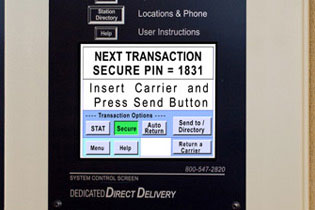
West Chester Medical Center, part of the Health Alliance of Greater Cincinnati, is a 160-bed state-of-the-art hospital in West Chester, Ohio. It provides the latest technology delivered in a healing environment offering a full-service emergency department, inpatient and outpatient, diagnostic and treatment services. Part of this world-class, leading edge technology was a brand new delivery system that provided dramatically improved speed of delivery, unmatched security and immediate cost savings.
West Chester Medical Center partnered with Colombo Pneumatic Tube Systems to design and install a state-of-the-art Direct Delivery System with SecureTrak. This “best in class” model provides a dedicated system for lab, pharmacy and sterile stores individually configured to maintain guaranteed turn-around times for all deliveries. Separate “clean” and “dirty” systems increase patient and staff safety, a leading concern for every healthcare provider.

The lab and the pharmacy are 100% in control of the system at all times with the ability to call back a carrier at any given moment. Colombo completely eliminated the opportunity for delivery error as the system is designed to allow contents to only be sent to one station. And, if a station must be shut down it can be isolated so it doesn’t contaminate the entire system. The balance of the stations can continue to operate as normal while the issue at the station is corrected. “The state pharmacy inspector was extremely pleased to see the new designs of our pneumatic tube system by Colombo. We believe we are on the cusp of a new paradigm in hospital design,” says Ronald Rohlfing, Vice President of Hospital Operations.

Typical multi-point systems or Global Computer Controlled Network Systems create an unnecessary backup in their overall systems by directing many stations into a single maze of tubes, increasing traffic jams within the system. Multi-point systems can take up to 16 minutes to transfer specimens, blood and medicine due to back ups in the delivery queue, which is unacceptable in most medical scenarios. Often specimens require a nurse to run the sample to the lab wasting important medical resources. Other disadvantages of a multipoint system include reduced security and increased likelihood for errors and cross contamination.
Rohlfing reports, “We have completely eliminated the need for pharmacy runners. The salary savings alone equates to $138,000 per year and that doesn’t take into account the time nurses used to spend running samples. Now they can focus on patient care rather that getting samples from point A to point B.”

Colombo’s Direct Delivery System transfers specimens and medication in approximately 20 seconds with the push of one button, eliminating all opportunity for error and increasing user confidence. The Direct Delivery System delivery time is predictable and repeatable while other systems delivery time is unknown due to backups in the system.
The Direct Delivery System is at the pinnacle in terms of security utilizing microprocessor-controlled circuitry and web browser viewable statistical and other analytic data from any authorized computer terminal. A card reader logs information every time an employee badge is swiped to open the pharmacy door. Different levels of security settings are employed for different levels of drugs, allowing only those with the highest security settings access to narcotics.

6″ Main Pharmacy Systems
Rohlfing reports, “The Colombo team brought greater value to our facility design by providing enhanced efficiency and safety with significantly improved medication chain of custody for medications tubed from our central pharmacy. Many hospitals employ pharmacy technicians to deliver medication on frequent distribution rounds. With our Colombo pneumatic tube stations, we can immediately send requested medications into locked medication supply rooms on the patient care units. The systems clinician receipt log based on employee badges provides unprecedented medication controls that the JOINT Commission will love.”
Download a printer-friendly version of the case study here.
